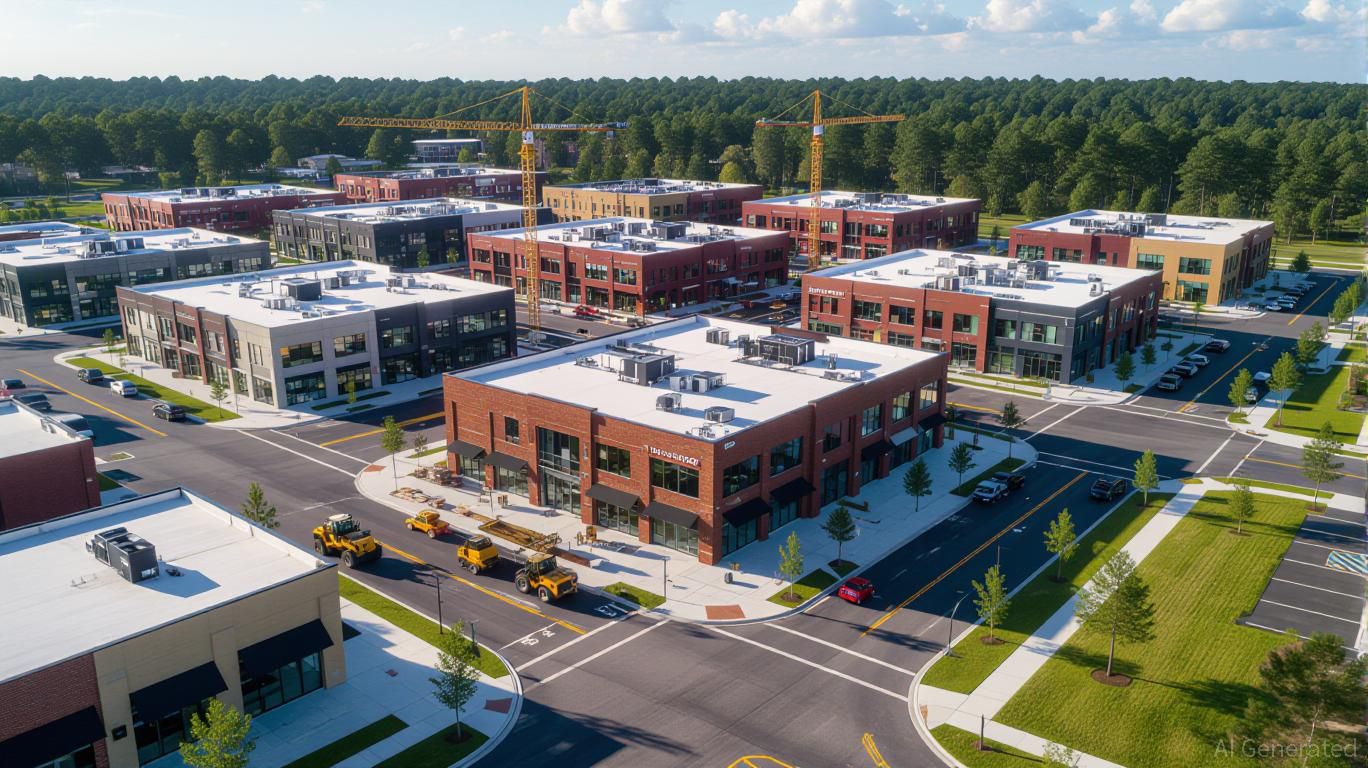The Economic and Infrastructure Boom in Webster, NY: Reasons Investors Should Pay Attention to the Xerox Campus Redevelopment
- Webster , NY's Xerox campus is undergoing a $9.8M infrastructure overhaul via FAST NY grants, repositioning the town as a high-growth industrial hub. - Strategic upgrades to roads, utilities , and mixed-use developments are attracting advanced manufacturing, food processing, and real estate investment. - Median home prices rose 10.1% annually by 2025, driven by improved connectivity and state-backed revitalization projects like the 600 Ridge Road site. - A 2026 timeline for completed infrastructure and m
Webster, NY: A Blueprint for Regional Renewal
Once in the shadow of Buffalo’s economic engine, Webster, NY is now gaining recognition as a standout example of regional transformation. Central to this resurgence is the redevelopment of the Xerox campus, a sprawling 300-acre former industrial site. Thanks to a $9.8 million infrastructure investment from New York’s FAST NY grant program, this area is being completely reimagined. Strategic collaborations between public and private sectors are fueling Webster’s rise as a thriving industrial center, drawing in advanced manufacturing, food processing, and semiconductor supply chain businesses. For investors, the combination of modernized infrastructure, a diversifying economy, and rising property values presents a unique chance to benefit from the town’s upward trajectory.
Infrastructure: The Engine of Economic Growth
The overhaul of the Xerox campus goes far beyond a simple property upgrade—it’s a targeted solution to address regional economic disparities. Governor Kathy Hochul’s commitment to building a “sustainable economic ecosystem” is coming to life through focused infrastructure improvements. The FAST NY grant is funding essential enhancements to transportation, utilities, and electrical systems, positioning Webster to compete with leading industrial regions in the Sun Belt for new tenants. These upgrades are already delivering results: the $650 million fairlife® dairy facility, which will generate 250 jobs, is a direct outcome of the site’s improved accessibility and capacity.

Webster’s proximity to Buffalo’s port and rail infrastructure further enhances its attractiveness. With industrial vacancy rates at just 2%, the town is outperforming many established manufacturing centers, appealing to companies eager to avoid shipping delays and high labor expenses. This surge in demand is tangible, not theoretical. The ongoing infrastructure projects, scheduled for completion between 2023 and 2025, coincide with the West Webster Hamlet Revitalization Project, which is transforming the 600 Ridge Road site into a vibrant, walkable community. These initiatives are about more than just construction—they’re about cultivating environments that draw talent, innovation, and investment.
Strategic Planning Fuels Real Estate Growth
The positive economic momentum is already translating into significant gains in the real estate market. A market analysis from November 2025 reports that the median price for single-family homes in Webster has climbed to $317,600, marking a 10.1% increase over the previous year. This surge is fueled by infrastructure improvements, such as upgraded roads, enhanced pedestrian pathways, and a $90,000 investment from the Community Access Project to boost walkability, making the town increasingly appealing to both residents and businesses.
The upcoming 2027 townwide property reassessment is expected to further accelerate this trend by ensuring property values accurately reflect the town’s new infrastructure and economic prospects. As both industrial and residential developments mature, property valuations will become more consistent, especially in areas near the Xerox campus and the revitalized 600 Ridge Road corridor. For investors, this signals a clear path of appreciation and growth.
Seizing the Moment: Why Invest Now?
The alignment of infrastructure completion and site readiness creates a rare window of opportunity for investment. By 2026, the West Webster Hamlet Revitalization Project will have converted a neglected area into a dynamic mixed-use neighborhood, while the Xerox campus will be fully equipped for advanced manufacturing operations. These projects are part of a larger $283 million state initiative to expand Upstate New York’s industrial sector.
Investors looking to get in early should focus on sectors set to benefit from this momentum: industrial land, logistics hubs, and residential developments designed for the growing skilled workforce. The new fairlife® dairy plant, for example, will drive demand for supporting services and housing, creating a ripple effect throughout the local economy. Additionally, the Sandbar Waterfront Revitalization project highlights Webster’s commitment to diversifying its economy, incorporating retail and tourism alongside manufacturing.
Conclusion: Setting the Standard for Regional Growth
Webster’s ongoing transformation demonstrates the power of strategic infrastructure investment in driving both economic and real estate advancement. By tackling long-standing underinvestment and aligning with state priorities, the town is establishing a virtuous cycle of growth and opportunity. For investors, the message is clear: communities that combine thoughtful infrastructure planning with forward-thinking economic strategies are not just surviving—they’re flourishing. As Webster’s property values and industrial activity continue to rise, the real question is how quickly investors can act to take advantage of the town’s promising future.
Disclaimer: The content of this article solely reflects the author's opinion and does not represent the platform in any capacity. This article is not intended to serve as a reference for making investment decisions.
You may also like
Investors Look for Stability Amid 2025 Meme Coin Craze
- 2025 crypto market sees renewed meme coin frenzy, led by $APEING's whitelist-driven presale and viral tokens like Pepe and Bonk . - Projects prioritize community engagement and structured participation to mitigate speculation risks while expanding into mainstream finance via ETPs. - Market analysis highlights $1.93B Pepe's price projections and Solana-based Bonk's Swiss ETP listing, signaling sector maturation amid regulatory uncertainty. - Analysts warn of volatility and speculative bubbles, urging inve

Breaking Down Blockchain Barriers: Avail's Nexus Brings Together Liquidity and Execution
- Avail's Nexus introduces a cross-chain infrastructure to unify liquidity and execution across major blockchain ecosystems, acting as Web3's "execution spine." - The platform uses intent-solver architecture to automate optimal execution paths, eliminating manual bridging and fragmented liquidity management. - It enables seamless user experiences and streamlined developer integration via SDKs, APIs, and modular tools across Ethereum , Polygon, and other chains. - Industry analysts highlight Nexus as a pote

Stellar News Today: U.S. Bank Introduces Stellar Stablecoin to Establish Benchmark for Regulated Digital Assets
- U.S. Bank tests Stellar-based stablecoin with PwC and SDF, joining traditional banks adopting blockchain for financial innovation. - Stellar's asset-freeze, transaction-reversal features and 99.99% uptime align with banking compliance needs like KYC protocols. - The pilot highlights Stellar's low-cost, rapid settlements (3-5 seconds) and institutional reliability, attracting major financial players. - The project aims to create a regulated, deposit-backed stablecoin alternative to USDT/USDC, potentially

Global postponements in crypto taxation highlight challenges in regulatory frameworks
- UK's 2025 Budget sparks global focus on crypto tax challenges amid fragmented regulations and delayed frameworks. - South Korea postpones crypto tax to 2027 due to unclear definitions, while Switzerland delays OECD CARF adoption until 2027. - OECD's CARF aims to automate cross-border crypto data exchange, with U.S. and South Korea aligning to combat offshore evasion. - UK prioritizes infrastructure spending over direct crypto regulation, highlighting tensions between economic growth and digital asset gov
